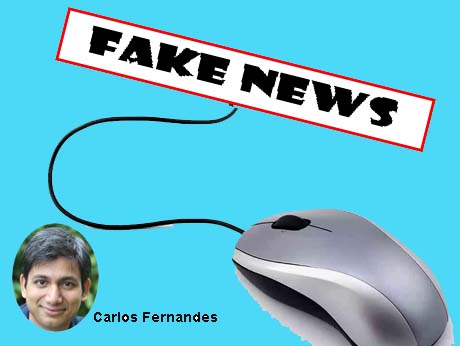
Against the background of widespread discussion on Fake News in India, this week,we bring you this opinion piece by a media industry leader.....
By Carlos Fernandes
April 4 2018: The public has changed the way they stay informed. 20 years ago they would flip through newspapers or tune into a news channel on their televisions. 10 years ago they would visit news websites. It was only in 2011, that things began to change as social media began to go mainstream. By 2014 Facebook had virtually doubled its referral traffic to media sites from to 22% from 12% the previous year. Consumers had come to expect news to come to them instead of visiting news websites.
With significant traffic coming from Facebook, news publishers were faced with a Hobson’s choice. Throw resources into their Facebook pages and optimize their content for social media or die. News publishers had inadvertently allowed for the creation of a powerful intermediary between them and their customers. Their future became inextricably linked to Facebook’s newsfeed algorithm.
The rise and fall of clickbait
Optimizing content for clicks placed a high burden on reporters and editorial teams, where they were judged not by the quality and rigor of their work, but the velocity with which it traveled. Highly researched and fact-driven news was expensive to create, drew less clicks and therefore was less monetizable. Facebook rewarded content that was read, liked or shared. This ushered in an era of progressively more sensationalist and exaggerated titles known as ‘clickbait’. For example, articles with titles that included, “You won’t believe what happened next…” became a Facebook staple.
The companies that were to thrive in this new world had it down to a recipe - the ‘right’ headline was one that built curiosity by keeping the true topic of the article hidden until you click. People hated it, but found it clicking irresistible. It worked. Upworthy, the media company that pioneered this, became the fastest-growing media site of all time. Then, Facebook stopped prioritizing content based on clicks alone - instead they prioritized content based on how much time users spent on the site after the click. All of a sudden, stickiness was prioritized over clickiness and publishers had to figure out ways to make people linger on their articles. Regrettably, that had an unintended consequence.
The Rise of Fake News
Facebook killed clickbait, only to drive news publishers to search for the “next viral thing” - a new form of news - news where the articles were just as sensational as the headlines. And how do you make sensational and viral news that not only grabs a reader’s attention but actually triggers readership? News that is unexpected, outlandish and unbelievable. In other words, news that could simply be fake. Facebook unwittingly created an environment that fostered the substitution of something that was annoying with something that was truly dangerous.
It is therefore unsurprising that fake news ‘performed’ better than real news prior to the 2016 US presidential election - most notably the top story on Facebook was the (fake) story of Pope Francis endorsing the then Presidential candidate, Mr. Trump. The problem became widespread. According to a Pew Research Center survey, 23% say they have shared a fake news story, 14% have said they shared a story that they knew was fake at the time they shared it and 16% said they found out a story was fake after they shared it.
In a lengthy analysis, Wired magazine outlines how a small Macedonian town of 55,000 was the registered home of 100 pro-Trump websites that were rewarded by Google Adsense revenue. This only happened because the fake news was shared and re-shared at a blistering pace, driving considerably more traffic than anything else would. ‘Boris’ a teen from Macedonia, apparently earned $16,000 in ad-revenue from his two Trump websites. This worked out to be many multiples of the average monthly salary in Macedonia, which is $371.
This is not to say that it is just economic incentives that drive fake news. Of course, here have been efforts by bad actors who have used technology to influence elections, create discord and engage in information warfare. These negative intentions, however, are not new. It just becomes a lot easier to manipulate people at scale when you have to work to fool just one algorithm. It is easy to forget that Facebook is designed to engage us; not to inform or educate us. That’s our fault. Not Facebook’s.
Carlos Fernandes is an entrepreneur in the media industry with television and news interests and a Young Global Leader at the World Economic Forum. He invented and patented the world’s first legal Internet-based Digital Video Recorder, in 2006. RecordTV, is among few companies on the forefront of disrupting the TV industry and was named as one of the Top 100 startups in the World by Red Herring Magazine.
India developments on curbing fake news... read of latest developments here